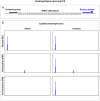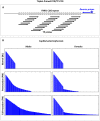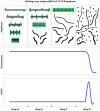Molecular Correlates and Recent Advancements in the Diagnosis and Screening of FMR1-Related Disorders
- PMID: 27754417
- PMCID: PMC5083926
- DOI: 10.3390/genes7100087
Molecular Correlates and Recent Advancements in the Diagnosis and Screening of FMR1-Related Disorders
Abstract
Fragile X syndrome (FXS) is the most common monogenic cause of intellectual disability and autism. Molecular diagnostic testing of FXS and related disorders (fragile X-associated primary ovarian insufficiency (FXPOI) and fragile X-associated tremor/ataxia syndrome (FXTAS)) relies on a combination of polymerase chain reaction (PCR) and Southern blot (SB) for the fragile X mental retardation 1 (FMR1) CGG-repeat expansion and methylation analyses. Recent advancements in PCR-based technologies have enabled the characterization of the complete spectrum of CGG-repeat mutation, with or without methylation assessment, and, as a result, have reduced our reliance on the labor- and time-intensive SB, which is the gold standard FXS diagnostic test. The newer and more robust triplet-primed PCR or TP-PCR assays allow the mapping of AGG interruptions and enable the predictive analysis of the risks of unstable CGG expansion during mother-to-child transmission. In this review, we have summarized the correlation between several molecular elements, including CGG-repeat size, methylation, mosaicism and skewed X-chromosome inactivation, and the extent of clinical involvement in patients with FMR1-related disorders, and reviewed key developments in PCR-based methodologies for the molecular diagnosis of FXS, FXTAS and FXPOI, and large-scale (CGG)n expansion screening in newborns, women of reproductive age and high-risk populations.
Keywords: AGG interruption; CGG repeat; FMR1; FXPOI; FXTAS; fragile X syndrome; melting curve analysis; methylation; screening; triplet-primed PCR.
Conflict of interest statement
Samuel S. Chong is an inventor of the dTP-PCR and msTP-PCR CE and MCA assays. Indhu-Shree Rajan-Babu declares no conflict of interest.
Figures



Similar articles
-
FMR1 Disorders.1998 Jun 16 [updated 2024 May 16]. In: Adam MP, Feldman J, Mirzaa GM, Pagon RA, Wallace SE, Amemiya A, editors. GeneReviews® [Internet]. Seattle (WA): University of Washington, Seattle; 1993–2025. 1998 Jun 16 [updated 2024 May 16]. In: Adam MP, Feldman J, Mirzaa GM, Pagon RA, Wallace SE, Amemiya A, editors. GeneReviews® [Internet]. Seattle (WA): University of Washington, Seattle; 1993–2025. PMID: 20301558 Free Books & Documents. Review.
-
Towards a Better Molecular Diagnosis of FMR1-Related Disorders-A Multiyear Experience from a Reference Lab.Genes (Basel). 2016 Sep 2;7(9):59. doi: 10.3390/genes7090059. Genes (Basel). 2016. PMID: 27598204 Free PMC article.
-
Triplet-Repeat Primed PCR and Capillary Electrophoresis for Characterizing the Fragile X Mental Retardation 1 CGG Repeat Hyperexpansions.Methods Mol Biol. 2019;1972:199-210. doi: 10.1007/978-1-4939-9213-3_14. Methods Mol Biol. 2019. PMID: 30847793
-
[Triplet expansion cytosine-guanine-guanine: Three cases of OMIM syndrome in the same family].Med Clin (Barc). 2016 Apr 1;146(7):311-5. doi: 10.1016/j.medcli.2015.11.022. Epub 2016 Jan 6. Med Clin (Barc). 2016. PMID: 26776484 Spanish.
-
Simplified strategy for rapid first-line screening of fragile X syndrome: closed-tube triplet-primed PCR and amplicon melt peak analysis.Expert Rev Mol Med. 2015 May 4;17:e7. doi: 10.1017/erm.2015.5. Expert Rev Mol Med. 2015. PMID: 25936533 Free PMC article. Review.
Cited by
-
Genetic and maternal predictors of cognitive and behavioral trajectories in females with fragile X syndrome.J Neurodev Disord. 2018 Jun 20;10(1):22. doi: 10.1186/s11689-018-9240-2. J Neurodev Disord. 2018. PMID: 29925305 Free PMC article.
-
Of Men and Mice: Modeling the Fragile X Syndrome.Front Mol Neurosci. 2018 Mar 15;11:41. doi: 10.3389/fnmol.2018.00041. eCollection 2018. Front Mol Neurosci. 2018. PMID: 29599705 Free PMC article.
-
Association between mutations in the FMR1 gene and ovarian dysfunction in Brazilian patients.JBRA Assist Reprod. 2022 Apr 17;26(2):237-240. doi: 10.5935/1518-0557.20210063. JBRA Assist Reprod. 2022. PMID: 34542254 Free PMC article.
-
Activation Ratio Correlates with IQ in Female Carriers of the FMR1 Premutation.Cells. 2023 Jun 24;12(13):1711. doi: 10.3390/cells12131711. Cells. 2023. PMID: 37443745 Free PMC article.
-
Tall Stature: A Challenge for Clinicians.Curr Pediatr Rev. 2019;15(1):10-21. doi: 10.2174/1573396314666181105092917. Curr Pediatr Rev. 2019. PMID: 30394212 Free PMC article. Review.
References
-
- Saul R.A., Tarleton J.C. FMR1-Related Disorders. In: Pagon R.A., Adam M.P., Ardinger H.H., Wallace S.E., Amemiya A., Bean L.J.H., Bird T.D., Fong C.T., Mefford H.C., Smith R.J.H., et al., editors. GeneReviews(R) University of Washington; Seattle, WA, USA: 1993.
Publication types
LinkOut - more resources
Full Text Sources
Other Literature Sources
Medical

